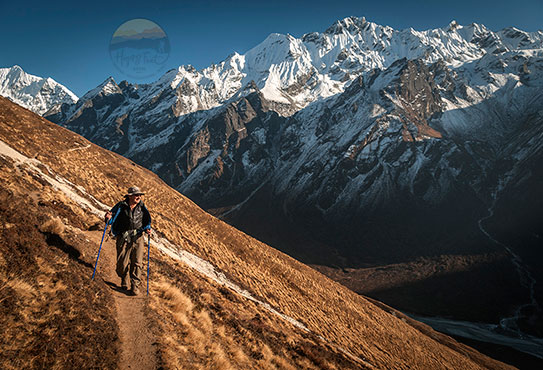-
Sunday - Friday: 9 AM - 4 PM
The Langtang region trekking area lies north of Kathmandu Valley within Nepal’s second-largest National Park, dominated by Langtang Lirung, 7246m, the region’s highest peak. The Langtang National Park is enriched by over 1000 plant species, 150 bird species, and several elusive wildlife, including pandas and snow leopards. The Gosainkunda Lake at 4300 metres and the Dorje Lakpa range of 6988 metres bisect the park from east to southeast. The majority of the inhabitants are Tamang and Tibetan, the Kirungbas. The southwestern region of Langtang, leading to Kyirong, the borderline between Nepal and Tibet, is known as the Tamang Heritage Trail and makes for a beautiful cultural trek. The park also contains spiritual sites such as the Buddhist monastery at Kyanjin Gonpa, Langtang and Gosainkunda Lakes, which are sacred to Hindus and Buddhists.
Langtang National Park contains various climatic zones, from subtropical to alpine. Approximately 25% of the park is forested. Trees include deciduous oak, maple, pine, and different types of rhododendrons. The wildlife in the Langtang National Park consists of Himalayan black bears, Himalayan tahr, rhesus monkeys, snow leopards, red pandas, and wild boars, with stories of Yeti sightings adding to the region’s mystique.
Langtang is amongst ancient settlements in the Himalayan Bases, with a monastery at Langtang village and another ancient monastery at Kyanjin Gonpa 3830m, at the base of Langtang Lirung Himal. This main ancient settlement, the Langtang village, was wholly swept away by a massive avalanche caused by the earthquake of 25th April 2015, which resulted in more than 310 deaths, including 176 residents, 80 foreigners, and 10 military personnel. More than 100 bodies (estimated) are still missing.
To the east of Langtang and Gosainkunda Lake lies the Helambu region, separated by the high passes of Ganja La and Gosainkunda (Lauribina La) Pass. Helambu, about 80 km northeast of Kathmandu, is a beautiful region known for its stunning scenery and is home to the Hyolmo people. The word Helambu is said to derive from the Tibetan words (Hye – Potato and Labu – Radish). The Helambu region begins at the Lauribina La pass and descends to Melamchi. Once famed for short cultural treks, Helambu has become one of the most sought-after trekking areas, containing several monasteries, stupas, and sacred Buddhist pilgrimage sites framed by the great snowy peaks of the northern and eastern horizons.
Suppose you travel here in summer, coinciding the full moon day of July-August, during Janai Purnima, which is a sacred day among the Hindus and local Buddhists. Hundreds of Jankris (Shamans) gather, beating drums, twirling rhythmically in skirts, and trickling perspiration under their peacock feather headdresses s they move from shrine to shrine. It is a chance to see a bit of Nepali Culture that casual visitors usually miss.
During the full moon of Janai Purnima, the Brahman and Chhetri men change their sacred thread. Every Hindu tie the Raksha Bandhan (protective bond) around their right wrist. The thread is thought to bring good fortune and is worn for 3 months until Lakshmi Puja (the cow/light festival). The wearer removes it and re-ties it on the tail of a Cow. Re-tying this thread on a cow’s tail is believed that after the person’s death, a cow will be waiting to offer her tail to the soul for a pool across the river of death.
Later in the day, crowds gather to listen to a repartee group of singers. Men and women try to outdo each other with wit, humour and poetry. They go on for hours and hours and often have the crowd in stitches. Even if you cannot understand, it is fun to watch this “cultural sport.” When a truce is finally declared, singers agree to meet in the same spot the following years, and they often do so in this heavenly Himalayan cradle. A rare lively tapestry of culture, rituals, and joy in the Himalayas.
